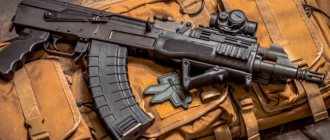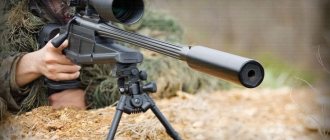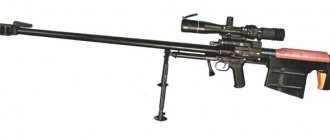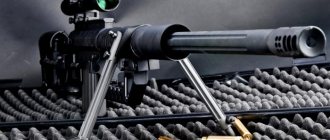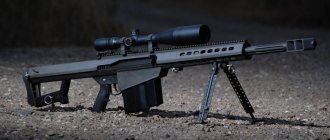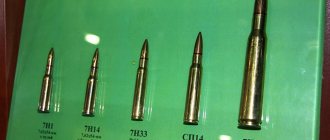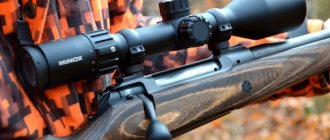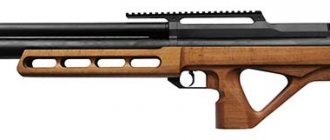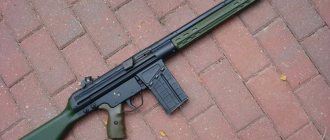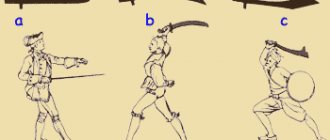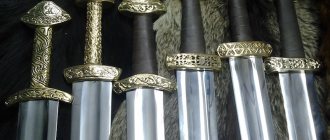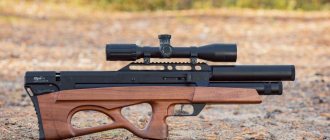What is caliber
Barrel gauge or bullet caliber is the internal diameter of a weapon barrel that characterizes a particular firearm.
It is necessary to know that all types of firearms are divided into two large groups depending on the internal design features of the weapon barrel: smooth, rifled. Each individual type is characterized by certain features and its own unique bullet calibers.
Changes in shells occur according to certain weapons standards. The caliber of the rifle is determined according to the English technique in fractions of an inch. For shotguns, the caliber measurement system is different: the caliber number is the whole number of round bullets that can be produced by casting 1 pound of lead.
In this case, an important condition is the spherical shape of the bullet, with the same mass and diameter, which is completely equal to the internal size of the central part of the gun barrel.
What is a bullet? A bullet for a firearm is a well-shaped striking part, used to cause maximum physical harm to the enemy.
Large-caliber weapons
Thunder 50 BMG pistol
This weapon is manufactured by an American company. Having set out on a unique idea to create a large-caliber pistol, the developers decided not to use pistol-caliber bullets. The first experiments were carried out with standard cartridges intended for a large-caliber sniper rifle.
The caliber of the pistol is 12.7x99 mm, first introduced in 2004. This pistol model is single-shot. The main design feature is the presence of a muzzle brake and a hydraulic system that is quite rare for this type of firearm.
It is responsible for the recoil of the barrel, due to which recoil during shooting is 20% less. The overall kinetic energy of the bullet is at the level of 15,500 J. The main disadvantage of this weapon model is the formation of flames emitted through the gaps of the compensator.
Sniper rifle Truvelo SR
On the world market you can now find a large number of rifles with large calibers. Not many people can boast of the same impressive bullet sizes as a 20*110 mm rifle.
The projectile was created by the Spaniards and at first it was intended for small anti-aircraft installations. African developers, assessing the impressive potential of the bullet, created a long-range sniper rifle for it.
The maximum firing range is 2 km, the rifle is capable of penetrating anything within this radius, including disabling an armored personnel carrier and other lightly armored vehicles.
Istiglal rifle
The main purpose of this weapon is to combat enemy equipment at medium and long distances. For this purpose, the rifle is equipped with fairly strong large-caliber 14.5 mm ammunition. As a rule, such a rifle destroys armored personnel carriers, aircraft, communication devices and other technical equipment.
Mortar
This is an experimental development of American scientists from the end of World War II. Today it is the largest cartridge in the world, 914 mm. With confidence, we can say that almost any even the most fortified target will be destroyed. But during the tests it became clear that the gun had insufficient range and accuracy for its use.
Large caliber sniper rifles
In addition to sniper rifles of conventional calibers (5.56 mm and 7.62 mm) widely used by the troops of all countries, in recent years increased interest has begun to be shown in equipping the armed forces and other security forces with large-caliber sniper rifles (KSV) of 12.7, 14 caliber .5, 15.2 and 20 mm.
This interest is due to the fact that the CSV, in addition to conducting counter-sniper combat and destroying manpower and combat assets in field fortifications and in urban environments, allows you to disable unarmored and lightly armored equipment, aircraft and helicopters in parking lots, missiles at launchers and at crossings , radar stations and other means of surveillance, communication and control, openly located ammunition and demolition devices. CSVs have become one of the main weapons systems of special forces units and units protecting their forces along the defense perimeter, destroying unexploded ordnance and demolition devices, allowing them to solve problems while being at a considerable distance from the target.
The history of the creation of large-caliber sniper rifles goes back to the thirties of the last century, when the Soviet Union developed and adopted the 14.5-mm Simonov PTRS anti-tank rifle, which was successfully used at the beginning of the Great Patriotic War.
The development and production of SWRs is currently underway in several countries, including Australia, Austria, Great Britain, Hungary, China, Poland, Russia, Serbia, the USA, France, Switzerland, the Czech Republic, Croatia, and South Africa.
Structurally, SWRs are made according to the classical scheme or according to the “bullpup” system with the location of some of the moving parts of the rifle in the butt. Using a bullpup layout allows you to make the rifle more compact.
Large-caliber sniper rifles can be non-automatic, when reloading is done manually, or self-loading.
To reduce recoil energies to the level of conventional small arms, the SWR can use a muzzle brake, which reduces recoil to 60-65%, recoil devices, a spring damper or a combination thereof, as well as a shock-absorbing pad on the back of the butt, which reduces recoil energy, which is especially important for SWR with a caliber greater than 12.7 mm.
For ease of aiming and greater stability when shooting, many large-caliber sniper rifles have a folding bipod, and some have the ability to adjust the design elements taking into account the individual characteristics of the shooter.
The weight of large-caliber sniper rifles, depending on the caliber, varies widely - from 6.3 to 29 kg, length in firing position - from 1110 to 2015 mm, muzzle velocity - from 720 to 1460 m/s, effective firing range - from 1000 up to 1300 m, magazine capacity - from 1 to 20 rounds. Ammunition used - 12.7x57, 12.7x99, 12.7x107, 14.5x114, 15.2x170, 15.2x207, 20x82, 20x83.5, 20 ×110 and 25x59V.
According to foreign statistics, the current record for the range of destruction of enemy personnel belongs to the Canadian sniper Corporal Rob Furloich from the 3rd Battalion of the Princess Patricia Light Infantry Regiment, who during the invasion of Afghanistan destroyed an enemy sniper at a distance of 2430 m using 12.7 -mm large-caliber sniper rifle "Mac Milan" with a sliding bolt. The previous record of 2250 meters belonged to Carlos Hatchcock and was set during the Vietnam War.
MAIN MODELS OF FOREIGN AND RUSSIAN LARGE-CALIBER SNIPER RIFLES
Currently, at least 40 models of large-caliber sniper rifles have been developed or are in service, among which the advantage is given to 12.7 mm rifles.
In the USA, the companies Fire Arch, Harris Gunvox, Knight Armament, Peregrine Industries, Pause, Harris (formerly Mac Millan), First Defense International, Chey, FA Manufacturing, Haskins and others are engaged in the development and production of large-caliber sniper rifles.
The most widely used large-caliber sniper rifles in the world are the Barrett series from Fire Arms - M82A1, M32A2 and M82AZ, which in addition to the USA are currently also used in 34 other countries, including the UK, France, Belgium, Denmark, Italy, the Netherlands , Norway, Portugal, Greece, Finland, Chile, Philippines, Saudi Arabia.
In the Barrett series, the most widespread are:
- M82A1 large-caliber sniper rifle is a self-loading basic model made according to the classical design and includes an air-cooled barrel with a short recoil, a receiver made integral with the butt and pistol grip, and a bolt carrier with a bolt. The barrel has a thread for a muzzle brake (reduces recoil by 60-65%) or a muffler. An optical sight is attached to the receiver, a folding handle for carrying, there are holes for better cooling, and a folding bipod can be installed. The butt has a shock-absorbing cushion. The standard Swarovski 10×42 optical sight has a rangefinder reticle that allows shooting at ranges from 500 to 1830 m. When shooting at night, night sights AN/PVS-4, AN/FVS-10 can be installed.
- M82A2 large-caliber sniper rifle with manual loading is made according to the bullpup layout and differs from the base model in reduced weight and size characteristics;
- The large-caliber sniper rifle M82A1M (XM 107) is still an experimental model. In Operation Iraqi Freedom, this rifle showed good results when shooting at personnel and vehicles. Thus, an Iraqi sniper who was on a water tower at a distance of 1400 m was destroyed by a sniper armed with such a large-caliber sniper rifle. It is believed that this SWR can be most widely used in battles in populated areas.
- The M82AZ SASR large-caliber sniper rifle was developed on the basis of a basic model specifically for arming the Marine Corps.
- Large-caliber sniper rifle "Barrett" M-90 , non-automatic, with a five-round magazine, made according to the bullpup scheme with manual loading.
- The Barrett M-95 large-caliber sniper rifle is developed on the basis of the M90A1 rifle and has recoil similar to that of a 7.62 mm rifle. The M-95 model uses new composite and metallized parts (titanium).
- Barrett M-99 large-caliber sniper rifle is single-shot, made according to the bullpup design, is a lightweight model and is considered by many experts as the best model of the Barrett series. Adopted by units of the US Special Operations Command.
At the beginning of 2003, based on the basic model of the M82A1 rifle, a prototype of the largest caliber sniper rifle in the world (25 mm) was developed, called the Barrett Payload Rifle (abbreviated AM PR) and designated XM-109 . The SSV uses 25x59V ammunition designed for OCSW (Objective Crew Served Weapon) weapons, designed to engage enemy targets at a distance of up to 2,000 meters.
The largest caliber sniper rifle in the world - 25mm Payload Rifle |
In the Harris series of large-caliber sniper rifles, the single-shot base model M-87 , on the basis of which a whole series of rifles has been created, including the M-87R , equipped with a five-round magazine; its layout is also used in the M-88 "Combo" and in the M-92 , created according to the bullpup design. Also popular is the M-93 rifle - a comfortable version of the KSV M-87K with a folding stock, reducing the overall length from 1346 mm to 991 mm. It uses a 10- or 20-round magazine.
The “miniature” SSV “Harris Desert Rainbow” has a mass of 6.3 kg, but its firing range is similar to the firing ranges of other large-caliber sniper rifles from this company.
the Wildrunner, a large-caliber sniper rifle that is lightweight and portable, has a length-adjustable stock, and is considered extremely accurate at long ranges.
continues to produce the Haskins .50/RAI Model 500 SWR, which was used extensively by the USMC in Beirut and Panama. This large-caliber sniper rifle has very good accuracy (0.5 MOA at a distance of up to 1800 m).
The Pause company produces a 12.7 mm lightweight self-loading SSV "Pause" 3-50 in a long-range version with a 740 mm barrel, weighing 13.6 kg and a light combat version with a 610 mm barrel and weighing about 10 kg.
TSW (Tactical Support Weapon) sniper rifle from Peregrine Industries has a 10-round magazine chambered for 12.7 mm Western-made cartridges and Soviet-designed cartridges.
SHILON rifle , developed by Chey and chambered for the .408 (10.4×77) cartridge, is manually loaded from a five-round magazine. It is believed that an experienced shooter with this SWR is able to put five bullets into a circle with a diameter of 12 cm at a distance of 1400 m, and according to the company, during testing, the point-firing range reached 2300 m. The rifle has a length of 1380 mm and a weight of 8.5 kg.
The large-caliber sniper rifle SR-50 from Knight Armament (combined Knight Stoner and Arme Light) is a self-loading 12.7 mm rifle, has a box magazine with a capacity of 10 rounds, which is placed horizontally on the left side of the receiver.
The Namessis large-caliber sniper rifle was developed on behalf of the US Special Operations Command, is a lightweight version of the French KSV Heketi II series, has a five-round detachable magazine, manual reloading, and allows you to quickly replace the standard 700 mm barrel with a 400 mm silencer. The weight of the rifle is 10-13 kg.
British large-caliber sniper rifle .AW50 |
In the UK, large-caliber sniper rifles are produced by Accuracy International:
- The KSV AS-50 is self-loading, with a folding stock and a detachable five-round magazine, and weighs 14 kg.
- AW.50 series SWR is five-shot, has two models - AW.50F and AW.50FT, differing in length and weight. This large-caliber sniper rifle is equipped with a recoil device with aluminum cylinders, adjustable butt pads and cheek pads.
These large-caliber sniper rifles have been adopted by unexploded ordnance destruction teams.
In France, large-caliber sniper rifles are developed by PGM Precision, Guitte, PRA, Stopson Robard:
- KSV “Hecate II” (HECATE II) is a series with manual loading, has a modular design and can be used with a conventional or composite stock. The rifle has a heat-absorbing coating around the barrel. It was adopted by special forces and other departments of France. Mini-HECATE option available. The KSV is developed and manufactured by a French-Swiss firm as part of the "Ultima Rotio" series of weapons sold by FN Herstal.
- KSV "Guitte .50" is a series of 12.7 mm bullpup rifles with manual loading and different barrels for shooting at different distances.
- KSV "Antis" is a 12.7 mm rifle chambered for standard and low-noise cartridges.
- KSV "Robar" .50 BGM , manually loaded, five-round, is considered by many experts as perhaps the most effective weapon option for snipers.
- Rendon Monster SCV , manufactured by PRA, is a five-shot gun with a folding stock, which makes it easy to transport, despite the long barrel (762 mm). The weight of this large-caliber sniper rifle is 15 kg. There is a standard Carl Zeiss 6-24×72 optical sight.
In Poland, ZTM produces a seven-round large-caliber sniper rifle WKW (LBSR) with a standard Leopold Wazi sight - X 4.5 - 14x50.
Hungary produces a series of five single-shot large-caliber sniper rifles “Top Gunn” and “Gepard” M1/M1A, using Soviet-developed 12.7 × 107 cartridges. The Gepard series also includes the semi-automatic M2 and M2A1 models with five- or ten-round magazines, the Gepard M4SA1 KSV with a ten-round magazine for 12.7x107 and 12.7x99 (.50 Browning) and Gepard ammunition M-3. In addition, KSV Gepard MZ, Elefant and Destroyer are produced in Hungary for 14.5x114 ammunition.
In Croatia, the Ratko Jankovic company developed single-shot large-caliber sniper rifles MACS-М2А and MACS-M3 chambered for 12.7×99, and the Alan company developed a single-shot 20-mm KSV RT-20 weighing 19.2 kg (Mk1) and 18 kg (Mk2 ) - with titanium parts. These large-caliber sniper rifles weigh at least 26 kg when fully loaded and use HS 404 (20x110) ammunition - armor-piercing incendiary (API) or high-explosive (HE). The KSVs are equipped with a Kakhles 6x42 optical sight.
In Serbia, the Zastava company produces the M-93 Black Arrow , which uses 12.7x99 and 12.7x107 cartridges.
In the Czech Republic, the ZVI company produces a large-caliber sniper rifle, the Falcon 96, chambered for 12.7 mm NATO or Soviet cartridges, which can use a 10x50 optical sight and a night sight. LCZ developed the KSV B-30, which uses interchangeable parts, including 12.7, 14.5 and 15.2 mm barrels.
In China, 12.7 mm large-caliber sniper rifles are produced by CJAJE.
| Russian large-caliber sniper rifle KSVK |
In South Africa, the Danel Land Systems company has developed, and the Mahonto Drull company produces, a large-caliber sniper rifle NTW 20/14.5 (New Technology Weapon) with a three-round magazine, which can use 14.5x114 or 20x82 ammunition without changing the main systems. This SWR uses a hydraulic-pneumatic buffer system with a large muzzle brake. The rifle is carried in two shipping packages. SWR length: with a 20 mm barrel - 1795 mm, with a 14.5 mm barrel - 2015 mm. In addition, the company was developing a new large sniper rifle for 20x110 ammunition with a mass of 31.5 kg. The NTW SWR can be equipped with parts for its use with NATO (12.7×99) or Soviet (12.7×107) cartridges.
The Truvello Amaury company developed the KSV SR-20 chambered for 20x82 mm.
In Austria, the company Steyr Mannlicher, back in the 80s of the last century, developed a large-caliber sniper rifle AM R (Anti-Material Rifle) chambered for 15.2×170 cartridge, which later received the designation IWS 2000 (Infantry Weapon System). The SWR is made according to the bullpup layout. To reduce the combat weight of the rifle, some of its parts are made of high-strength plastic and light metal alloys. An APPSDS armor-piercing sub-caliber cartridge with a feathered bullet and a detachable pan was created for this rifle. The SWR penetrates 40 mm thick armor plate at a distance of 1000 meters.
In Australia, Precision Rifle Systems produces a 12.7 mm ATAS .50 BG large-caliber sniper rifle.
Russian large-caliber sniper rifles are represented by the V-94, OSV-96 and KSVK systems, made according to the bullpup design and having thick cold-forged barrels, which increases shooting accuracy. All Russian large-caliber sniper rifles use 12.7x108 cartridges. The rifles are equipped with a PSO-1 optical sight, which is equipped with the 7.62 mm SVD sniper rifle.
AMMUNITION FOR LARGE-CALIBER SNIPER RIFLES
The ammunition of large-caliber sniper rifles, like all sniper rifles, differs from the standard ammunition of similar calibers used in conventional small arms. The dispersion of sniper rifle bullets should not exceed one thousandth of the firing range, therefore, sniper rifles usually use specially carefully manufactured batches of cartridges in which the bullets have the same mass and concentricity, the same mass of the powder charge, and the same geometric dimensions and internal volume of the cartridge case.
When assembling such ammunition, the depth of insertion of the bullet into the cartridge case and its compression, the depth and fastening of the primer are carefully observed.
| Ammunition for various sniper rifles |
Sniper rifles are rated by their shooting accuracy relative to MOA (Minute of Angle) - the angle of dispersion of a group of five bullets on a target. For example, 1 MOA corresponds to a 1" diameter circle at 100 yards (91 m) or a 2" diameter at 200 yards, etc. So if a gun is said to provide a 1 MOA group, that means that at 300 yards the gun should be capable of placing five bullets in a circle no larger than three inches in diameter. Many sniper rifles, when using the proper ammo, should deliver 0.5 or even 0.3 MOA, which equates to a one-inch group diameter at 300 yards, 2 inches (50 mm) at 600 yards (550 m).
In the early 80s of the last century, a revolution occurred in sniper business, when the Finnish developed the .338 Lapua Magnum (8.6 × 70) sniper cartridge, which has a 16.2-gram muzzle with an initial flight speed of 914 m/s, which increased the practical range of destroying a person from the first shot to a distance of 1100 m and six times exceeded the kinetic energy of a 7.62 mm NATO cartridge, which has a muzzle energy of 6770 joules and 4790 joules at a distance of 300 m from the muzzle. In addition, the .338 cartridge has a 25% lower drop trajectory and 50% less deflection in a 4 m/s crosswind. The manufacturer claims that the inherent accuracy of this cartridge allows you to increase the effective firing range to 1500 m, and the accuracy at this distance will be 0.25 MOA. The .338 Lapua Magnum cartridge occupies an important niche between the 7.62 mm NATO and other .300 ammunition, on the one hand, and the 12.7 mm cartridges, on the other. “Super Magnum” (by Accuracy International), TRG-21 (Sako), “Super Mag” (Mac Millan), Mini-HECATE (PGM Precision) and others were developed for the .338 Lapua Magnum cartridge However, despite its excellent characteristics, the .338 Lapua Magnum cartridge still remains an ammunition for firing exclusively at enemy personnel, since its bullet is too small to be used with damaging fragments or incendiary charges against structural materials and protected targets.
In this regard, the most widely used 12.7 mm large-caliber sniper ammunition is currently based on the 12.7 × 99 mm (.50 Browning) cartridges developed by the Americans for Browning heavy machine guns and the cartridge developed in the Soviet Union 12.7x107 mm.
In the United States, the first experiments to create a 12.7 mm large-caliber sniper rifle chambered for the M2 heavy machine gun ammunition were carried out during the Korean War, when the Americans captured several Soviet-made North Korean anti-tank rifles and, having slightly modified them, began to use them for their tests. Tests have shown that a 12.7 mm bullet with an initial speed of 854 m/s has an initial energy of 16774 J and that a 12.7 mm armor-piercing incendiary bullet versus a 7.62 mm NATO cartridge has almost three times the effective range of destruction at the same initial bullet speed. In addition, a heavier bullet allows for higher armor penetration. Thus, a 12.7 mm armor-piercing bullet penetrates a 25 mm armor plate at 300 m and a 13 mm armor plate at 1200 m, versus 14 mm at 100 m and 10 mm at 300 m for a 7.62 mm armor-piercing bullet. As for the accuracy of 12.7 mm ammunition, it is 1-1.5 MOA at a distance of up to 1500 m, which is approximately the size of a human torso or the nozzle of an airplane jet engine and a helicopter turbine. This accuracy also allows the 12.7 mm large caliber sniper rifles to be used to destroy floating mines, scattered anti-tank mines and other explosive objects and improvised explosive devices from a safe distance.
12.7 mm large caliber sniper rifles can use multi-purpose ammunition.
14.5x114 ammunition was widely used in Simonov and Degtyarev PTRS anti-tank rifles during the Great Patriotic War and in heavy machine guns of the KPV, DShK series and continues to be produced for large-caliber sniper rifles produced in the former Warsaw Pact countries and some other states. This ammunition can penetrate 25 mm thick armor plate at a distance of 100 m, which is twice the armor penetration of 12.7x99 mm ammunition.
APFSDS ammunition (13.2x170) is used in the IWS 2000 and can penetrate 40 mm thick armor plate at 1000 m.
The HS 404 (20×100) ammunition, designed for land, sea and aviation automatic chucks, has high-explosive (HE), high-explosive incendiary tracer (HEI-T), armor-piercing (AP) and other bullets.
25x59V ammunition for OCSW (Objective Crew Served Weapon) provides effective shooting at a range of 2000 m; in addition to a conventional contact fuse, a non-contact time fuse can be installed on it. The ammunition uses high-explosive, fragmentation or cumulative bullets.
World experience shows that currently 12.7 mm large-caliber sniper rifles and, as an exception, SWRs of other calibers are mainly used.
SIGHTS FOR LARGE-CALIBER SNIPER RIFLES
Sights are an integral part of all sniper rifles. Typically, each type of sniper rifle has a standard optical sight. However, nowadays other scopes can be used in sniper rifles. Mainly used are daytime telescopic optical sights and night sights. Recently, sights with laser rangefinders have begun to be used, which makes it possible to almost instantly determine the range to a target with high accuracy. Thermal imaging sights have also appeared, providing target detection through obstacles (for example, in dense foliage) and in complete darkness.
Russian large-caliber sniper rifles currently use modified PSO-1 telescopic sights, which have only a 4x magnification, and a 1PN-51 night sight, although telescopic sights with variable magnification (1P21), with target illumination (POSP 8×) have already been developed 42) and a universal collimator (PK-01).
Foreign sights usually have a 10x magnification.
The most common sights used in foreign large-caliber sniper rifles are: Swarovski 10×42, AN/PVS-7A., night AN/PVS-4, night-day AN/PVS-10 with 12.5x magnification, "Carl Zeiss" 3-12x56, 4-16x56 and 6-24x72 SAM, Vare-X 4.5-14x50, "Kahles" 6x42, "Lenpold" 10x30, 2, 5-10×42.
The development of large-caliber sniper rifles, their ammunition and scopes continues. The main directions, in addition to the creation of systems for standard NATO ammunition and Soviet-designed ammunition, increased-caliber ammunition and specially designed ammunition (high-explosive fragmentation, armor-piercing incendiary and cumulative), are the unification of the use of the base model for firing cartridges of various calibers and the creation of combined systems.
Performance characteristics of the main large-caliber sniper rifles
| Rifle brand | Capacity store, Patr. | Weight, kg | Length, mm | Barrel length, mm | Ammunition | Effective firing range, m | Initial bullet speed, m/s |
| "Barrett" M82A1 | 10 | 13,6 | 1448 | 737 | 12,7×99 | 1500-2000 | 853 |
| "Barrett" М82А2 | 10 | 12,24 | 1409 | 737 | 12,7×99 | 1500-2000 | 853 |
| "Xappis" M87R | 5 | 9,52 | 1346 | 737 | 12,7×99 | 1500-2000 | 853 |
| "Barrett" M90A1 | 5 | 9,52 | 1143 | 737 | 12,7×99 | 1500-2000 | 853 |
| "Harris" M92 | 5 | 10,9 | 1346 | 737 | 12,7×999 | 1500-2000 | 853 |
| "Harris" M93 | 10 or 20 | 9,52 | 1346 | 737 | 12,7×99 | 1500-2000 | 853 |
| Harris M95 | 5 | 8,11 | 1143 | 737 | 12,7×99 | 1500-2000 | 853 |
| "Harris" M96 | 10 or 20 | 13,61 | 1232 | 737 | 12,7×99 | 1500-2000 | 853 |
| "Harris" M99 | 1 | 11,3 | 1128 | 838 | 12,7×99 | 1500-2000 | 853 |
| "Harris Deseart Rainbow" | 1 | 6,3 | — | 419/508 | 12,7×99 | 1500-2000 | — |
| "Arma Light" VK-50 | 1 | 13,1 | 1499 | 788 | 12,7×99 | 2000 | 853 |
| ATAS .50 BG | 6 | 15,3 | 1450 | 900 | 12,7×99 | 1500-2000 | — |
| Knight StonerZK-EO | 10 | 13,6 | 1470 | 902 | 12,7×99 | 2000 | 853 |
| Windrunner | 5 | 11,3 | 1220 | 711 | 12,7×99 | 1000-1500 | 853 |
| AW.50F | 5 | 13,64 | 1350 | 686 | 12,7×99 | 1500 | 840 |
| AW.50FT | 5 | 12,73 | 1120 | 686 | 12,7×99 | 1500 | 850 |
| "Hecate II" | 7 | 13,5 | 1380 | 700 | 12,7×99 | 1800 | 840-850 |
| "Geparl" Ml | 1 | 19 | 1570 | 1100 | 12.7x107 | 2000 | 842 |
| "Cheetah" М1А1 | 1 | 22 | 1570 | 1100 | 12.7x107 | 2000 | 842 |
| "Cheetah" M2 | 5 or 10 | 16 | 1536 | 1 100 | 12,7×107 | 1200 | 838 |
| "Cheetah" M2A1 | 5 or 10 | 15 | 1266 | 830 | 12.7x107 | 1000 | 785 |
| "Cheetah" M4SA1 | 5 or 10 | 17 | 1450 | 800 | 12.7x107 | 2000 | 792 |
| "Cheetah" M5 | 5 million 10 | 17 | 1450 | 1000 | 12,7×99 | 2000 | 825 |
| MACS-M2A | 1 | 12,4 | 1470 | 780 | 12,7×99 | 1400 | 855 |
| MACS-M3 | 1 | 8,8 | 1110 | 760 | 12.7x99 | 1400 | |
| "Falcon 96" | 2 | 12,6 | 1380 | 927 | 12,7×107 | 2000 | 790-850 |
| "Falcon 97" | 2 | 12,5 | 1260 | 838 | 12.7x99 | 2000 | 855-925 |
| B-94 | 5 | 11,7 | 1700 | 1100 | 12,7×108 | 2000 | 900 |
| OSV-96 | 5 | 12,9 | 1746 | 1000 | 12,7×108 | 1800 | 840 |
| KSVK | 5 | 2 | 1400 | 1000 | 12,7×108 | 1500 | 840 |
Large caliber cartridges
- Cartridge 408 10.4×77. This bullet caliber was created relatively recently and is used for shooting at long distances up to 2 km. The cartridge was developed for large-caliber, heavy machine guns, but the bullet is now used on long-range sniper rifles.
- Bullet 12.7×108. The ammunition was developed in the Soviet Union in the late 1920s, specifically for the machine gun of that time. The bullet is still used in some countries today. It is used for firing large-caliber rifles and machine guns.
- Bullet 7.62. This is the largest revolver bullet of all time. The ammunition was created by a Smith & Wesson engineer. It was designed specifically for the new Magnum revolver because its design features can withstand high pressure, unlike conventional revolvers.
- Bullet 15 x 104 mm. This is a standard large-caliber bullet with an impressive weight of 75 g and a bottle-shaped case. The initial speed of the cartridge reaches 895 m/s.
- Caliber 12.7x99 mm. This is a pistol caliber created at the end of the First World War. This caliber is capable of causing significant damage to aircraft and tanks. Nowadays these cartridges are used not only as pistol cartridges, but also as machine gun cartridges.
When choosing and purchasing a firearm, the first thing you need to do is decide on its caliber. To do this, you need to clearly understand for what purposes the weapon will be used, and only after that you need to move on to choosing the brand and type of pistol, rifle, etc.
Large-bore shotguns 10 gauge and larger
Photo by Evgeniy Kopeiko
From a pound of lead, four ball bullets are really 113 g projectiles for an old quarter-pounder gun.
But such colossal bullets have not been and are not fired from hunting weapons, even large-caliber ones.
The point is not only in calculating the caliber of a weapon based on the number of round bullets, but also in the actual size of the shells of a hunting weapon.
A hunting rifle is a rifled weapon with a folding block of barrels of the same caliber (traditional) or different (the so-called “mountain”).
It doesn't necessarily need to be larger than 12 gauge, or .729 inches. Of the modern ones, the smallest is the Peter Hofer caliber .17WMR, and the largest is the Holland-Holland Royal caliber .700N.E., or the same Verney-Carron, or Ziegenhahn.
By the way, the rifled caliber .700N.E. The diameter is very close to 14 gauge. It is the large-caliber Verney-Carron fitting, presented by the company at the Moscow exhibition ARMS&Hunting-2017 in Gostiny Dvor.
Large-caliber hunting weapons can be any type of hunting weapon, both smooth-bore guns and rifles; caliber is a parameter of the barrels, and not a characteristic of the type of weapon.
In the century before last - the 19th century, fittings of larger calibers were produced for cartridges with black powder; the calibers of these weapons were calculated by the number of round bullets cast from one pound of lead according to the British measurement system, that is, weighing 453.6 grams.
Read the material “Wad container affects the quality of the shot”
But the bullets for these “elephant” and other fittings were not necessarily spherical; as a rule, they were of a sealed design and weighed less than the nominal spherical ones.
There were large smoothbore guns of 10, 8, 4, and even 4 calibers. The essence of these large-caliber samples lies in their purpose; they were usually shot with shot, and, if necessary, with a bullet.
Among them were the so-called “clarifiers” for hunting in places where waterfowl accumulated. These are heavy guns, and especially large ones were fired from special rests installed on a boat or in a hideout.
But it is not at all necessary that supposedly large-caliber rifles were fired with shells of nominal caliber.
Nowadays, a projectile weighing 45 g for a 12-mag caliber shotgun is not surprising; there are also magnum category shotguns and cartridges on sale, but this is a 10-gauge projectile. And then a projectile of such mass was almost the limit; not everyone dared to fire heavy projectiles.
But there were, and still are, typical large-caliber hunting rifles; these are examples of a traditional design with a folding block of barrels, certainly heavy and brutal, but whose somewhat lower mass to some extent allows them to be shot handheld. Usually these are 10- and 8-gauge shotguns; they were produced in different countries.
Read the material “Lead shot is not dangerous for hunters and their families”
Let me remind you that the nominal bore diameter of the 10th caliber is 19.69 mm, and that of the 8th caliber is 21.21 mm, respectively. Shotguns of 10 and 8 gauges were common in the late 19th and early 20th centuries; hunters needed models for large shot shells.
The chambers did not exceed a length of 85 mm; such a cartridge case could accommodate a shot shell up to the nominal value. They not only hunted with them, but even shot at them in “pigeon” cages.
| Photo by Anton Zhuravkov. |
And our ITOZ plant produced a 10-gauge single-barrel breech-loading trigger gun with a folding barrel, as well as an 8-gauge one with a barrel length from 890 to 980 mm.
They cost much more, respectively 30 and 50 rubles in terms of the 1911 exchange rate, than the same smaller gun - 12 gauge, offered for 26 rubles. Prices and photographs 2 and 3 are taken from “Rates No. 9 for 1910/11 of the armory of A.A. Bitkova in Moscow" from my archive.
By the way, the Tula company TsKIB SOO also produced a 10-gauge MTs10-10 double-barreled shotgun. Now I’ll just remind you of its main parameters: the barrels are heavy, weighing 1.9 kg, the block is steel, the weight of the gun is 4.13 kg.
I draw your attention to the length of the chambers - 70 mm; This gun is intended to fire only pellets of nominal caliber, weighing 45 g or less, but not more. The permitted pressure is indicated by the inscription “no more than 700 kg/cm2” on the barrels.
Read the material “How to make a high-quality cartridge yourself”
It is obvious that this solid double-barreled shotgun, despite its mass, does not belong to the now common “magnum” category.
Once upon a time in Moscow, a Belgian 8-gauge hunting horizontal rifle was offered, massive, but very interesting and in very good condition. The design is standard, a folding barrel block, locks in the block, triple locking of the barrel block, a pistol-shaped stock.
Of course, you can shoot such a double-barreled shotgun once or twice, and then put it on your backpack to concentrate and gather strength before the next doublet. It had to be abandoned, but only due to the lack of branded cartridges; now it is no longer possible to find them, unless collected abroad individually at specialized auctions.
Such a rare gun requires real factory cartridges with paper shells, and not homemade ones.
By the way, the absence of shell casings determined its good condition, since the previous owner had nothing to shoot with.
As an example of a very large-caliber hunting weapon, an ancient French muzzle-loading single-barrel 4-caliber gun, made in the 1830s–1840s in Saint-Etienne, deserves attention.
Read the material “Algorithms for long-range shots with large shot”
Its weight is only 3.0 kg with a barrel length of 700 mm, and the bore diameter of the 42 caliber corresponds to 26.72 mm in the metric system. However, no one was ever going to shoot nominal caliber shot shells from it, which would have amounted to 113 grams every time.
Neither this gun with very ordinary parameters, nor the hunter himself could withstand such shooting due to excessive recoil.
In fact, this is a small, elegant gun, albeit a 4-caliber one, it was created with the goal of producing a wide scatter of shot at the usual distance of 35 meters when shooting shot shells of no more than 36 grams that are familiar to a hunter of average physical ability.
| Photo by Evgeniy Kopeiko |
This Saint-Etienne antique ramrod with a primer lock, despite the colossal 4-gauge, is a typical hunting rifle of the second quarter of the 19th century, made in Western Europe.
So, in the Saint-Etienne Museum, I examined a muzzle-loading double-barreled shotgun from 1836–1840. locally made with the same stock, decorated in the Rocaille style, safety bracket, semicircular hammers with a capsule lock. A similar gun of similar decoration and design is also in the Liege Museum.
Unfortunately, the photographs of the Saint-Etienne 4-caliber single-barreled gun turned out to be mediocre, and the owner wished to remain incognito, so we will have to limit ourselves to only a slightly more detailed description.
It is important that the barrel on it is steel, very durable, although it would be more logical to see a Damascus barrel on a gun of that period. The length of the steel barrel is only 672 mm, and with a breech screw it is equal to 701 mm, this is quite a bit for a 4-caliber gun, but fully corresponds to its purpose - creating a wide scree at a normal distance.
Read the material “You can get a report for a gas canister in a car”
At the breech, the barrel is octagonal, in the middle with a large number of edges, sixteen of them, and in the last third of the length towards the muzzle it is round. The lock is a capsule lock, with a spectacular semicircular trigger. All parts are steel, from the breech and lower base of the trigger mechanism to the safety guard and butt plate with a long upper shank.
The stock is long, with a protrusion under the cheek and a semi-pistol neck, decorated with carvings in the “smooth rocaille” style. Branded swivels indicate that this gun was intended to be carried for hunting.
The 4-caliber Saint-Étienne single-barreled shotgun is an expensive, high-end, individually handcrafted shotgun. The trunk is decorated in gold in the Empire style with floral ornaments in the form of vines, leaves and flowers, among which two fabulous birds in the French style are depicted in gold, we call them firebirds.
The steel parts of the gun are also decorated with engraving, right down to the breech and trigger. The ramrod in the muzzle-loading model is a necessary and trivial item; without it, the gun cannot be loaded, but graded hard wood, a horn tip and precise, neat work allow it to be classified as decorative elements of the gun.
Now the old 10- and 8-gauge shotguns have supplanted modern models of the magnum category, but the owners of the surviving large-caliber models carefully store and shoot them, loading the cartridges in branded cartridge cases from the previous stocks.
You can ask your question to Evgeniy Kopeiko by email
Evgeniy Kopeiko June 10, 2022 at 11:30
